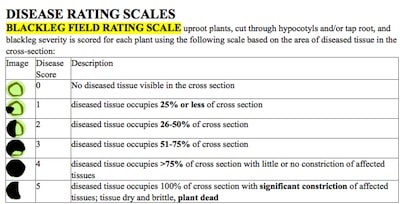Just before or while swathing are the best times to check plants for blackleg and other diseases. Uninfected parts of the plant still have some green colour, making discoloration due to disease infection easier to see. Swathed stems can also be analyzed, but this should happen within a few days. As the plants die, other saprophytic breakdown — decay — may look like blackleg and confuse the diagnosis. Blackleg symptoms themselves can also become less obvious.
Blackleg identification tips
Low level infection. Upper parts of the plant will remain green and healthy right through to natural maturity. Upper stem lesions or leaf lesions may be present, perhaps due to infection of hail damage wounds. Blackleg lesions are usually white or grey with a dark border. Fruiting bodies called pycnidia — which look like black specks — form in the centre of the lesion. Risk to next canola crop: Blackleg expressed only as upper stem and leaf lesions is unlikely to cause much yield loss in the current crop, and are rarely a source of inoculum for future years. With low level infection, you may still find 1 or 2% of the stems where infection has moved into the crown. Clipping the base of stems may show some necrosis of the stem.
Moderate infection. 10-20% of plants show some necrosis due to basal cankers. The dry rot that results gives lower stem tissue a woody texture. (Stems where the tissue is constricted or girdled is not typical of basal cankers and may be a different root disease.) Clipping the base of the stem may show some blackened tissue inside, but transfer of nutrients up and down the stem continues. Some plants will die prematurely, and exhibit yield loss, but most plants mature minimizing overall yield. Risk to next canola crop: Infected crowns break down slowly and are a source of inoculum for future years, increasing the risk of blackleg in canola grown on the field over the next 2 or 3 years.
Severe infection. Areas in the field have lodged or have prematurely ripened plants. These plants will be brown to light brown or tan coloured while healthy plants remain green. Crowns may appear irregular, and clipping will show that infection has grown through the stem and cut off nutrient flow to the plant. More than half the area of the stem is darkened by the fungus, and the root may be rotted off just below the soil surface. Substantial yield loss is certain. Risk to next canola crop: Infected crowns break down slowly and are a source of inoculum for future years, increasing the risk of blackleg in canola grown on the field over the next 2 or 3 years. The more plants with severe infection, the greater the amount of infected residue that needs to break down in order to avoid significant spore production next time canola is grown on that field.
Need clippers. To accurately diagnose without clippers is difficult. Clippers provide a nice clean cross section, better than a jack-knife and better than splitting the stem by hand.
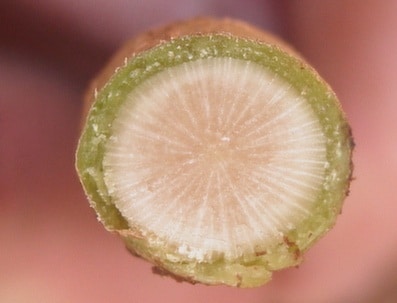
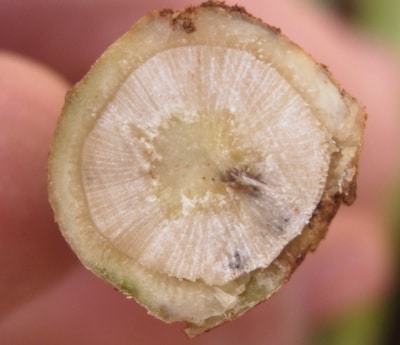
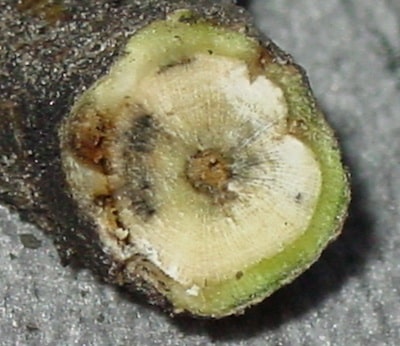
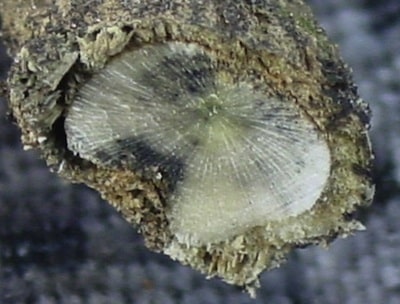
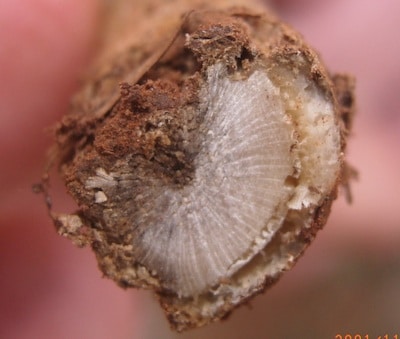
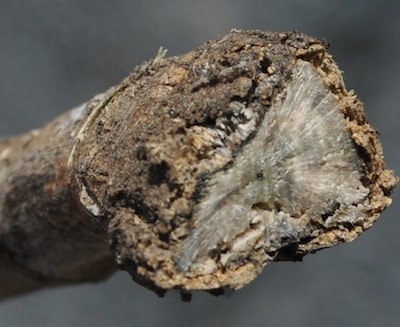
Blackleg management options
Identifying blackleg in a field before serious yield loss occurs gives you more management options. Management options are:
Longer canola rotation. Adding one extra year to rotation might be worth doing if you can prevent major yield loss to the disease. A severe outbreak in a field may force you into a much longer rotation to manage blackleg effectively in the next canola crop on that field, not to mention the yield loss penalty/cost the year of the wreck.
Grow varieties with disease resistance. Definitely grow a resistant “R” variety if you didn’t before. If an “R” rated variety had moderate or high levels of blackleg, then the variety’s blackleg resistance genes are no longer effective against the blackleg races in the field. Switching to another “R” rated variety may help. Growers don’t know which varieties have which resistance genes, but rotating varieties creates an opportunity to bring a mix of resistance genes to the field over time. On the other hand, growing the same variety repeatedly ensures selection pressure for the pathogen to overcome the resistance in that variety.
Control volunteers. Canola volunteers and related weed species, such as wild mustard, can host blackleg and other canola diseases in non-canola years. If not controlled, these volunteers and weeds act as a disease bridge, reducing the effectiveness of rotation and variety resistance for disease management.
Use certified seed. With certified seed, each canola plant should have the same genes and be equally resistant. Seed treatments can control seed-borne blackleg infection, but do not protect seedlings and plants from later infection.
Consider fungicide. Early season infection is what leads to yield-reducing cankers. Fungicides are registered to manage this early season infection. Fungicide to manage blackleg is not common practice but may be necessary in some fields.
More on disease assessment at swathing
Disease scouting podcast with CCC’s Greg Sekulic
More on blackleg management tips

